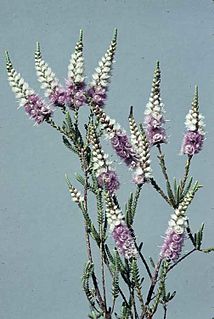Verticordia forrestii, commonly known as Forrest's featherflower, is a flowering plant in the myrtle family, Myrtaceae and is endemic to the north-west of Western Australia. It is a shrub with small, egg-shaped leaves and massed displays of scented pink to red flowers in spring.

Verticordia plumosa, commonly known as plumed featherflower, is a flowering plant in the myrtle family, Myrtaceae and is endemic to the south-west of Western Australia. It was the first species in the genus to be described, although initially given the name Chamelaucium plumosum. It is a shrub with linear leaves and rounded groups of scented pink, mauve or white flowers. Two varieties of this species have been declared as being "threatened".
Verticordia albida is a flowering plant in the myrtle family, Myrtaceae and is endemic to the south-west of Western Australia. It is a shrub with one main stem with many branches and spike-like groups of scented, white feathery flowers with a pink centre.
Verticordia crebra, commonly known as Barrens featherflower, crowded featherflower or Twertup featherflower, is a flowering plant in the myrtle family, Myrtaceae and is endemic to the south-west of Western Australia. It is a sprawling shrub with crowded, cylinder-shaped leaves with small, yellow flowers that are almost hidden by the leaves but with a style which extends well beyond the petals. The plant looks superficially like a miniature pine tree.

Verticordia halophila, commonly known as salt-loving featherflower, or salt-loving verticordia, is a flowering plant in the myrtle family, Myrtaceae and is endemic to the south-west of Western Australia. It is an erect, bushy shrub with small, crowded, thick leaves and spikes of red and pink flowers in spring.
Verticordia harveyi, commonly known as autumn featherflower, is a flowering plant in the myrtle family, Myrtaceae and is endemic to the south-west of Western Australia. It is a slender, spindly shrub with relatively long leaves and small white, pink or magenta-coloured flowers in late summer and autumn.

Verticordia helichrysantha, commonly known as coast featherflower or Barrens featherflower, is a flowering plant in the myrtle family, Myrtaceae and is endemic to the south-west of Western Australia. It is a small, woody, open-branched shrub with crowded, linear leaves and small yellow flowers from May to September.

Verticordia spicata, commonly known as spiked featherflower, is a flowering plant in the myrtle family, Myrtaceae and is endemic to the south-west of Western Australia. It is usually a dense, bushy shrub with small leaves pressed against the stem and spikes of pink flowers from late spring to early summer.

Verticordia pritzelii, commonly known as Pritzel's featherflower, is a flowering plant in the myrtle family, Myrtaceae and is endemic to the south-west of Western Australia. It is a compact, woody shrub with several main stems, small, linear to club-shaped leaves, and rounded groups of deep pink flowers from late spring to mid-summer.

Verticordia picta, commonly known as painted featherflower or china cups, is a flowering plant in the myrtle family, Myrtaceae and is endemic to the south-west of Western Australia. It is a small to medium sized shrub with pink and cupped flowers that are sweetly scented.

Verticordia fastigiata, commonly known as mouse featherflower, is a flowering plant in the myrtle family, Myrtaceae and is endemic to the south-west of Western Australia. It is a prostrate or low shrub with small, club-shaped leaves and mouse-scented flowers which vary in colour from golden-yellow and orange to dark red.

Verticordia fimbrilepis, commonly known as shy featherflower, is a flowering plant in the myrtle family, Myrtaceae and is endemic to the south-west of Western Australia. It is a small, bushy shrub with one openly branched main stem at its base, small, pointed leaves and rounded groups of pink flowers near the ends of the branches.
Verticordia fimbrilepis subsp. australis, commonly known as southern shy featherflower is a flowering plant in the myrtle family, Myrtaceae and is endemic to the south-west of Western Australia. It is a slender shrub with one openly branched main stem at its base, small, pointed leaves and rounded groups of pink flowers near the ends of the branches.

Verticordia inclusa is a flowering plant in the myrtle family, Myrtaceae and is endemic to the south-west of Western Australia. It is a small shrub with small, thick leaves and groups of scented, mostly white to pale pink flowers with a red centre on the ends of the branches in spring.

Verticordia laciniata is a flowering plant in the myrtle family, Myrtaceae and is endemic to the south-west of Western Australia. It is an openly branched shrub with linear, slightly hairy leaves and heads of scented, bright yellow flowers which turn red then bronze-coloured as they age.

Verticordia roei, commonly known as Roe's featherflower is a flowering plant in the myrtle family, Myrtaceae and is endemic to the south-west of Western Australia. It is a shrub with narrow leaves and is often covered with masses of creamy-white coloured flowers in late spring.
Verticordia sieberi is a flowering plant in the myrtle family, Myrtaceae and is endemic to the south-west of Western Australia. It is a shrub with one main stem, often compact but sometimes openly branched and with pink to pale purple flowers in summer and autumn.
Verticordia stenopetala is a flowering plant in the myrtle family, Myrtaceae and is endemic to the south-west of Western Australia. It is a low shrub with small leaves and heads of pink to magenta-coloured flowers in late spring and early summer.

Verticordia tumida, commonly known as summer featherflower, is a flowering plant in the myrtle family, Myrtaceae and is endemic to the north-west of Western Australia. It is an open shrub with very small leaves and clusters of deep pink flowers from late spring to early winter.
Verticordia vicinella is a flowering plant in the myrtle family, Myrtaceae and is endemic to the south-west of Western Australia. It is a shrub with narrow leaves and groups of small, scented, pink or pale yellow flowers, growing near Esperance and in the Cape Arid National Park.












